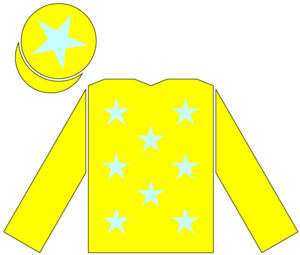Carroll House facts for kids
Carroll House (born March 5, 1985 – died February 8, 2008) was a famous Thoroughbred racehorse from Ireland. He was trained in Britain and became a father to other racehorses. During his racing career, which lasted from 1987 to 1990, he competed in twenty races across six different countries and won seven of them. His biggest victory was in October 1989 when he won the prestigious Prix de l'Arc de Triomphe in Paris, France. He also won other important races like the Phoenix Champion Stakes, Grosser Preis von Baden, and Princess of Wales's Stakes. After he stopped racing, he became a breeding stallion in Japan and Ireland.
Contents
Discovering Carroll House
Carroll House was a chestnut-colored male horse, known as a colt, with a white star marking on his face. He was born in Ireland. His father was a horse named Lord Gayle, who was also a successful racehorse and had many winning children, like Blue Wind. Carroll House's mother, Tuna, wasn't a great racer herself, but she gave birth to several other winning horses.
When Carroll House was very young, he was sold at an auction. A year later, he was sold again to a businessman named Gerald Carroll. Carroll House was then sent to be trained by Michael Jarvis in Newmarket, England, a famous place for horse training.
Carroll House's Racing Journey
Starting Out: 1987
Carroll House had his very first race in September 1987. He was still quite young and learning, but he showed promise by finishing fourth. Three weeks later, he won his first race at Newbury Racecourse. This was a maiden race, which means it was for horses who hadn't won a race before. Experts thought he would become a very good horse.
Three-Year-Old Races: 1988
In 1988, Carroll House was ridden by jockey Bruce Raymond in most of his races. He finished third in a couple of races before heading to Italy for the Derby Italiano. He almost won, losing by a tiny bit on soft ground. After this race, an Italian owner named Antonio Balzarini bought Carroll House.
Carroll House then returned to the UK and won the Welsh Derby. Soon after, he raced in Germany. He finished first in a big race called the Grosser Preis von Berlin, but the race officials decided he had caused a problem during the race, so they moved him down to third place. A week later, he won another important German race, the Fürstenberg-Rennen. He then won Germany's most important race, the Grosser Preis von Baden, by a good distance. He raced in Italy again that autumn but didn't win.
Four-Year-Old Success: 1989
In 1989, Carroll House raced in England for the first time in over a year. He was not expected to win, starting at long odds, but he almost did, finishing second in a very close race. He then finished third in the Tattersalls Gold Cup in Ireland.
In July, Carroll House won the Princess of Wales's Stakes at Newmarket, beating another strong horse by a small margin. A few days later, he raced in the King George VI and Queen Elizabeth Stakes, one of Britain's biggest races. The ground was too firm for him, and he finished fifth.
On September 2, Carroll House won the Group One Phoenix Champion Stakes in Ireland. He came from behind to win by three-quarters of a length. Five weeks later, he competed in the famous Prix de l'Arc de Triomphe in France. This is one of the most important flat races in the world. Carroll House, ridden by Mick Kinane, was not the favorite, but he raced strongly and took the lead near the end, winning by one and a half lengths! After this huge win, Carroll House was sold to a Japanese breeder named Zenya Yoshida. He then raced in Japan but didn't perform well on the firm ground.
Final Races: 1990
Carroll House continued racing as a five-year-old, but he wasn't able to win again. His trainer found it hard to get him fully fit because the ground was very firm. He finished last in one race and fourth in another. During his last race, he got an injury that ended his racing career.
What Experts Thought
Horse racing experts, who use a system called Timeform, considered Carroll House an "inferior" winner of the Prix de l'Arc de Triomphe. This means while he won the big race, they thought other winners of that race were stronger overall.
Life After Racing: Stud Career
After his racing career, Carroll House began a new job as a breeding stallion, or "stud," in Japan in 1991. This meant he would father new racehorses. In 1996, he returned to Ireland to continue his stud career. He didn't have much success producing winners for flat races (races on a flat track), but he did have more success with horses that competed in National Hunt races, which involve jumping over obstacles. One of his children, Roll Along, won a big jumping race in 2008.


